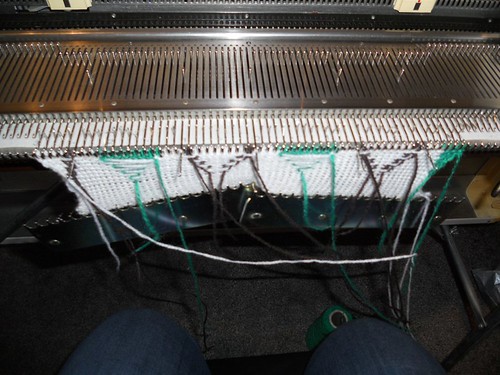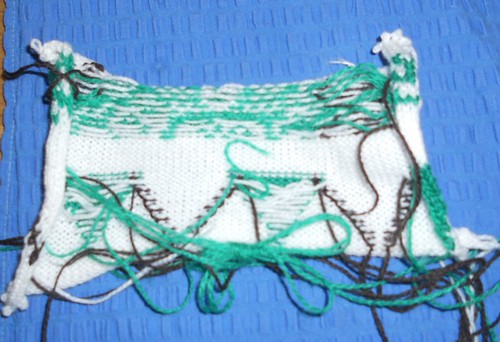So, the AG50 works in conjunction with the EC1/PE1 combination. You have your pattern split by colours, plus a blank pattern for the background, and all these must be memorised into the PE1 before starting. The PE1 splits each colour into rows. Type 1 intarsia basically selects 1 row of colour 2, then 3, then 1 (so it helps to do a free pass at the start if colour 1 is your background).
The first picture shows me just about to knit back the brown stripes by hand.

The next two pictures show the front and back of the sample I knitted.


I knitted the green and black bits (the argyle pattern) back by hand, and then you can lay the background yarn over the needles and knit that across. It's kind of intarsia crossed with fairisle as I didn't use seperate yarn for the background. I also forgot to loop the edge of the yarn around a neighbouring stitch, hence a rather holey edge. So in other words, the electronics selects which colours you should knit, but unless it's the background, you'll be knitting the other colours back by hand. A 30 row intarsia pattern will require 90 moves of the carriage, and everything except the background will need knitting back by hand (and you'll have to try and judge your tension).
I then had a go at type 2 (the leaves and grapes above the argyle). This is kind of embellished fairisle, but as each colour needs a move of the carriage it's more akin to slip-stitch patterning. Again, a 30 row pattern will require 90 passes of the carriage.
I then made a start on type 3 intarsia - which is plain old intarsia, but the pattern you load has the outline of a shape. You can choose to either knit the outline back by hand, and then knit the various colours by hand (in whatever colours you choose), and then knit the background, or you can choose to either knit the outline in the same colour as the background, or choose to make it part of the coloured areas (why you would do this I'm not certain!). I didn't manage to knit a sample of this, because I was completely mystified as to what colours I was supposed to be using at this point. I think it basically selects all needles to C position and leaves the border needles in B position, so it's probably closest to proper intarsia in that you'll make 30 moves to get a 30 row pattern.
Type 4 intarsia lets you knit a kind of double-bed jacquard but without the ribber. I was getting quite tired by this point so didn't attempt it.
This carriage falls firmly in the "why bother?" category for me. For: the machine selects the needles for you, so you can't possibly go out of pattern. Against: as each colour requires its own row, the more colours you add, the more passes you have to make to achieve them.
Personally, I think using the plain AG24 carriage, where you lay each colour over the needles as required, though more prone to error, is much quicker.
Current mood:
 annoyed
annoyed

1 comment:
I wonder... if the pre-selection of needles would be a useful tool for lace even though standard & fine already have a lace carriage. It might be helpful for pointing out which needle to use for "Magic Cables", real cables etc. About the only advantage Brothers sometimes have over Silver Reed. (sorry?) I'm heading off in a couple of days to a 4-day live-in "weekend", but have planned projects for my SK860 & chunky machines. Thank you for still being around :)
Post a Comment